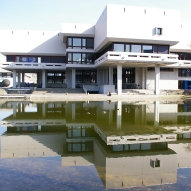Zusammenfassung
Structural variation and single-nucleotide variation of the complement factor H (CFH) gene family underlie several complex genetic diseases, including age-related macular degeneration (AMD) and atypical hemolytic uremic syndrome (AHUS). To understand its diversity and evolution, we performed high-quality sequencing of this similar to 360-kbp locus in six primate lineages, including multiple human ...
Zusammenfassung
Structural variation and single-nucleotide variation of the complement factor H (CFH) gene family underlie several complex genetic diseases, including age-related macular degeneration (AMD) and atypical hemolytic uremic syndrome (AHUS). To understand its diversity and evolution, we performed high-quality sequencing of this similar to 360-kbp locus in six primate lineages, including multiple human haplotypes. Comparative sequence analyses reveal two distinct periods of gene duplication leading to the emergence of four CFH-related (CFHR) gene paralogs (CFHR2 and CFHR4 similar to 25-35 Mya and CFHR1 and CFHR3 similar to 7-13 Mya). Remarkably, all evolutionary breakpoints share a common similar to 4.8-kbp segment corresponding to an ancestral CFHR gene promoter that has expanded independently throughout primate evolution. This segment is recurrently reused and juxtaposed with a donor duplication containing exons 8 and 9 from ancestral CFH, creating four CFHR fusion genes that include lineage-specific members of the gene family. Combined analysis of > 5,000 AMD cases and controls identifies a significant burden of a rare missense mutation that clusters at the N terminus of CFH [P = 5.81 x 10(-8), odds ratio (OR) = 9.8 (3.67-Infinity)]. A bipolar clustering pattern of rare nonsynonymous mutations in patients with AMD (P < 10(-3)) and AHUS (P = 0.0079) maps to functional domains that show evidence of positive selection during primate evolution. Our structural variation analysis in >2,400 individuals reveals five recurrent rearrangement breakpoints that show variable frequency among AMD cases and controls. These data suggest a dynamic and recurrent pattern of mutation critical to the emergence of new CFHR genes but also in the predisposition to complex human genetic disease phenotypes.






 Altmetric
Altmetric